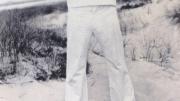In 1925 Henry Beston ’09, A.M. ’11, bought land in the peninsular dunes of Eastham, on Cape Cod, and commissioned a carpenter to build a house on a mound facing the Atlantic, 30 feet in from the beach. The Fo’castle consisted of a single room, 20 by 16, with a wood stove but no electricity. On this “last fragment of an ancient and vanished land,” the only neighbors were the hardy “surfmen” two miles north at the Nauset Coast Guard Station. Beston intended the house for summer visits but decided that first summer to spend a year there. His record of that year, The Outermost House (1928), has become one of the most beloved books in American literature. His protégée and friend, Rachel Carson, author of Silent Spring, once said it was the only book that ever influenced her.
Beston (he dropped “Sheahan” in his thirties) was born a doctor’s son in Quincy, Massachusetts. After earning his master’s, he taught English at the Université de Lyon before returning to Harvard in 1914 as an English instructor. The next year, he served as an ambulance driver for nine months in World War I. His first book, A Volunteer Poilu (1916), written to honor his French comrades, narrates his experience at the Battle of Verdun.
Next, he wrote fairy tales, hoping, as one critic put it, to “cleanse the horrors of war from his soul.” The Outermost House never mentions the war, but, like Hemingway’s “Big Two-hearted River,” it is a postwar story about a solitary man immersed in the natural world “beyond the violences of men.” “It was on the dunes that he found himself as a writer,” wrote his wife, Elizabeth Coatsworth, an admired author herself. “There he was alone most of the time with only the sea, the sky, the beach, and the marshes for company.”
Beston described himself as a “scholar with a poetic joy in the visible world.” House is not a story that gazes inward or seeks drama in self-analysis. All the drama and mystery lie in the dunes, the waves, the night air, the “elemental presences,” the great tidal rivalry between ocean and beach, and the struggles of men and birds at sea to survive winter’s fury. His readers watch and listen with him, drawn in by an enraptured yet precise prose style that evokes Shakespeare and the King James Bible. From observation Beston moves effortlessly to contemplation of nature’s secrets. “In a world older and more complete than ours,” he writes, fascinated by the mysterious synchronicity of migrating shorebirds, “they move finished and complete, gifted with extensions of the senses we have lost or never attained, living by voices we shall never hear. They are not brethren, they are not underlings, they are other nations.” In nature he finds the wisdom of humility and spiritual sustenance.
Beston and Coatsworth married in 1929 and honeymooned at the Fo’castle. When they found suburban Hingham too busy and trafficked, they bought Chimney Farm (now a National Literary Landmark) in rural Nobleboro, Maine, in 1932. There, where Beston lived the rest of his life, they wrote together, raised two daughters, befriended neighbors, tended their garden, chopped wood, paddled canoes, and explored the winter forest on snowshoes.
His Maine books, like Northern Farm, sing of harmonious, self-reliant country living: uncramped, governed by seasonal rhythms, connected to all the generations who’d farmed the land before them. “Without a farming population,” he maintained, “a nation is never healthy in spirit.” In Maine, he found “a way of life that has faced the age of the machine and preserved its communal goodwill and the human values.” His great gift, his wife felt, was to help readers discover what had been there all along—the forces that contour the land, the first signs of spring thaw, and their own yearning to be rooted in the earth. He was, she said, “a great opener of windows.”
In the anthology American Memory, Beston celebrated Native Americans, the early European explorers, and the great rivers flowing through “a wilderness that is wilderness no more.” The St. Lawrence River (1942), a narrative of his many trips along the river, takes his readers on “an adventure beyond politics and frontiers into the older America of the forest, the cataract, and the shadow of trees.”
But he was appalled by what this America had become. “I see no future for this form of civilization,” he wrote to a friend, “with its brutal egotism, its absence of poetic relation to the earth.” In the past century, he believed, America had suffered “an alienation from Nature unexampled in human history.” In college, a classmate once scribbled a cartoon of Beston’s tombstone, engraved “He hated machines.” Now, Beston was convinced, the Machine Age was destroying man’s “animal faith,” replacing responsibility with passivity, and debasing his very language. His daughter Kate Beston Barnes, Maine’s first poet laureate, once said, “He would have been horrified, just horrified, by the world of today.”
In 1959, Beston was awarded the American Academy of Arts and Sciences Emerson-Thoreau Medal. Two years later, due in part to the influence of The Outermost House, the Cape Cod National Seashore was established. In 1964, Beston returned to Eastham one last time to dedicate the Fo’castle as a National Literary Landmark. The dedication plaque reads “wherein he sought the great truth and found it in the nature of man.” He urged young visitors to the site to keep a reverence for nature in their hearts. The house was washed away by a hurricane in February 1978, but pilgrims still come each year to see the place where it stood.










